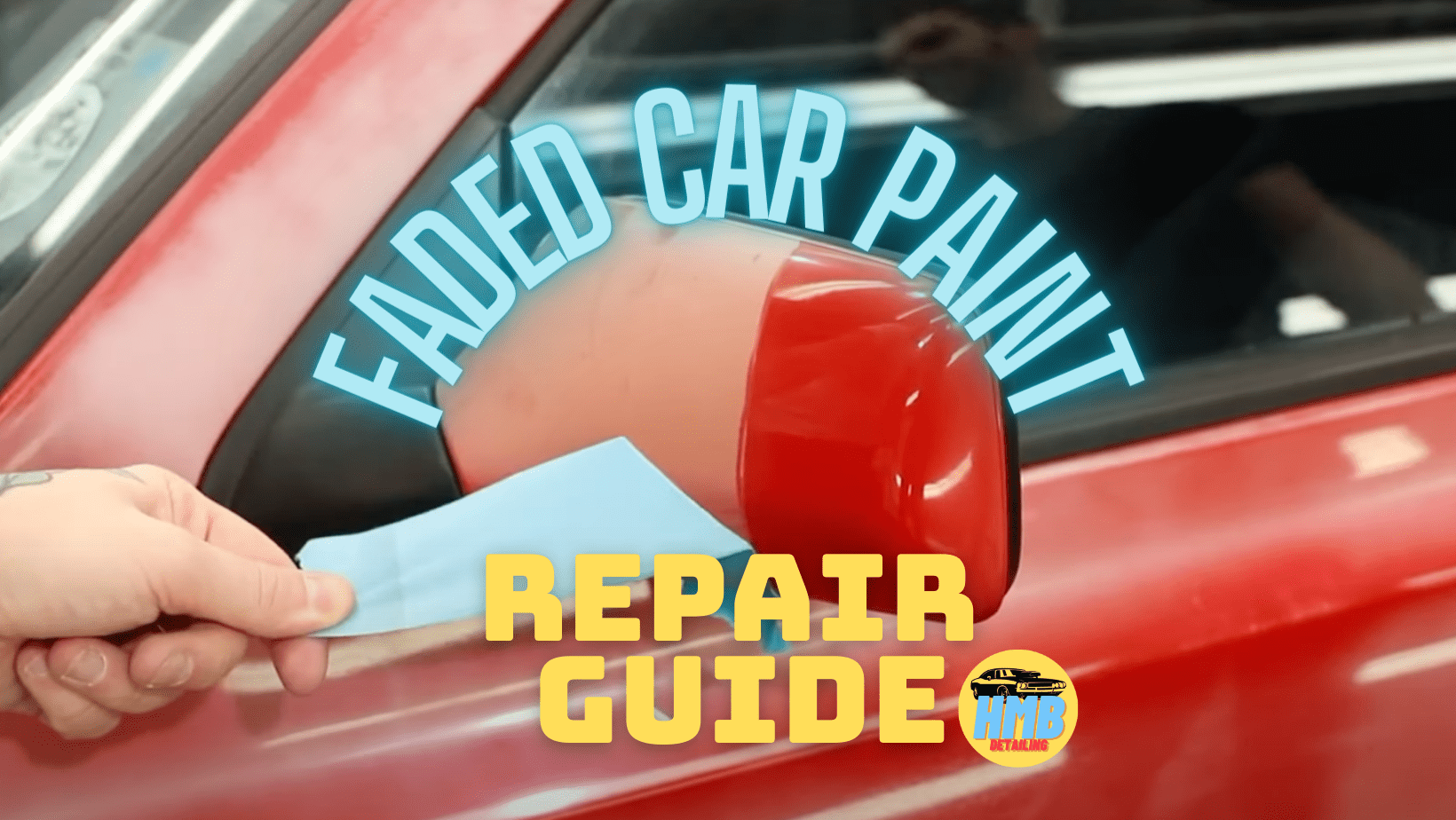Faded Car Paint Repair: Bringing Your Car Back to Life
Are you tired of looking at your car’s dull and faded paint? Faded paint affects your car’s overall look and can significantly decrease its resale value. However, depending on the severity of faded car paint you have, and with the right techniques and tips, you can restore faded or oxidized paint and bring your car back to life. Let’s dive deeper into faded car paint repair.
In this article, we will help you to recognize what severity of faded paint you have, how to fix it, what causes it, and how to prevent fading and oxidizing of your car’s surface.
Understanding the Causes of Faded Car Paint
Faded or oxidized car paint is a common problem on used cars and can make even a well-maintained vehicle look old and worn out. To properly repair and prevent faded car paint, it’s essential to understand what causes such a problem. Here are two main causes of car paint fading and oxidation:
1. UV Exposure: The Main Culprit

The sun’s UV rays are a powerful force that can create insane problems with your car’s paint. When UV rays reach your car’s surface, they break down the chemicals in the paint, which causes it to fade over time. Firstly, it harms your clear coat, so it can lose glossiness and become yellowish. A clear coat is a protective barrier, and once it’s damaged, the sun will start harming your paint’s base coat. The damage can increase by other factors, such as heat and humidity, which can cause the paint to dry out and crack. Some signs of UV damage include a chalky appearance, a rough texture, and a loss of shine.
2. Chemical Damage: How Car Paint Gets Eroded Over Time
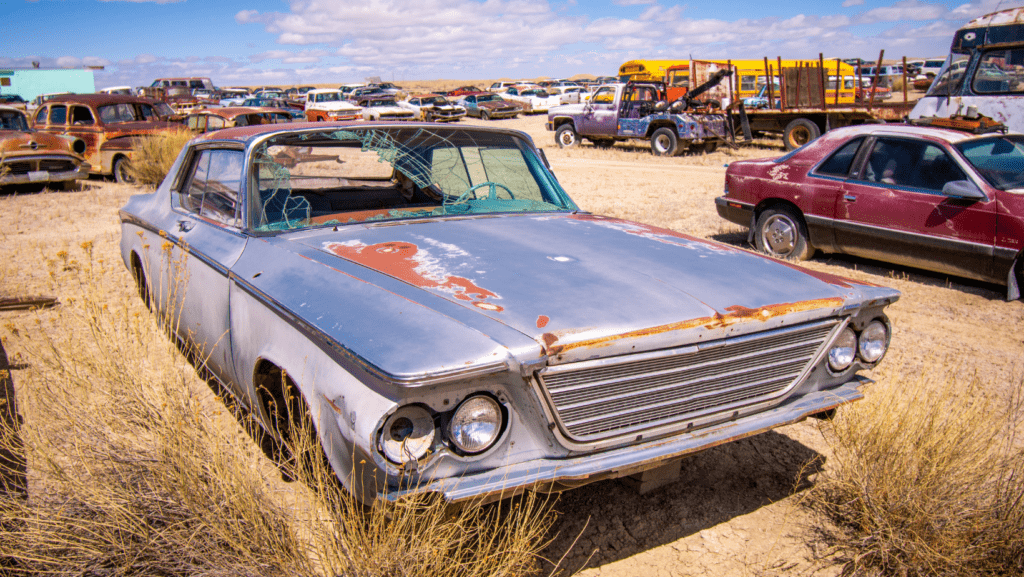
Another reason for faded and oxidized paint can be its exposure to harsh chemicals. Some chemicals can get on your car from the surrounding. It can be road salt, iron from brake pads, pollution, and bird dropping. We have a guide to remove bird poop stain from car. All these can erode the paint if not removed on time and cause the paint to fade and oxidize.
Using household cleaning products or too harsh chemicals on your car can also cause chemical damage and fading of paint and color changes. Also, even using proper car care products but not following their instructions can harm your paint.
The Severity of Faded Car Paint
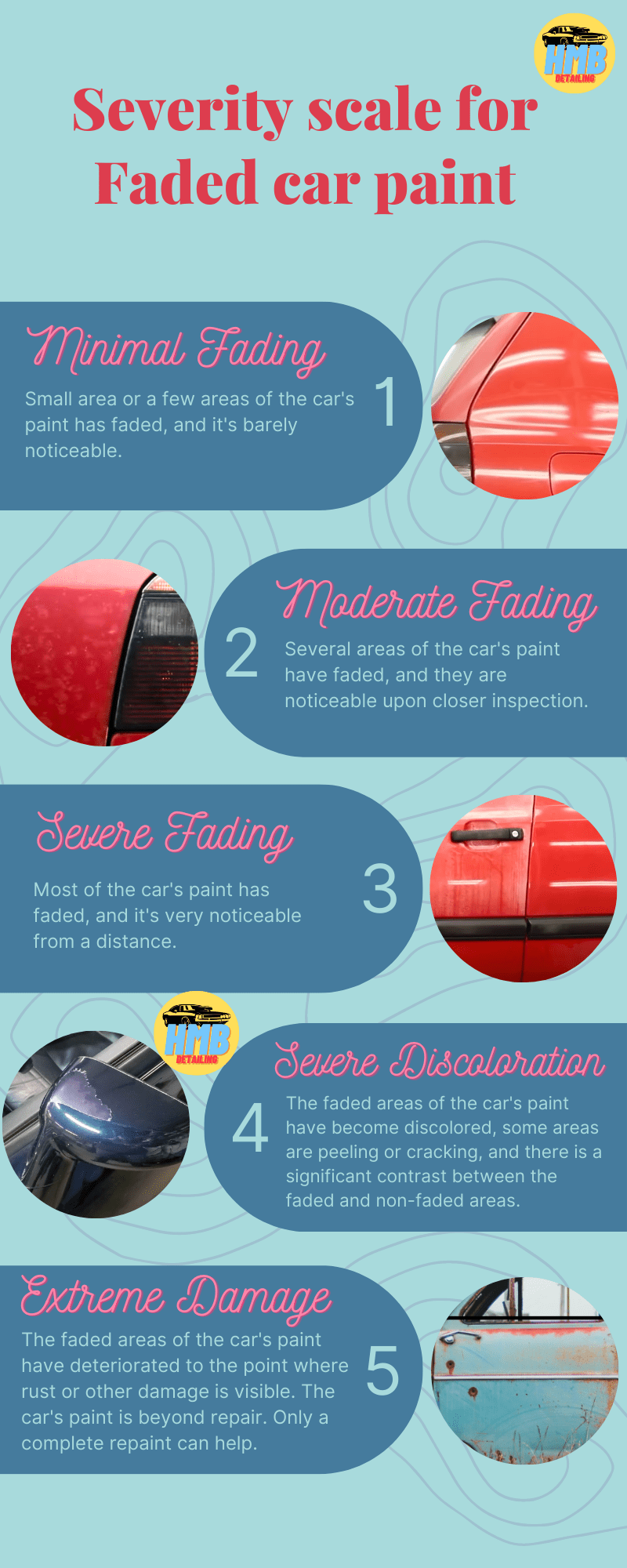
The severity of faded car paint can range from a minor blemish to a major eyesore. To pick the best course of action for repair, you need to check first what severity of the damage you have. Also, when you know how to recognize the beginning of fading or oxidation of car paint, you will have a higher chance to repair it with minimal effort and avoid complete repainting of body parts.
The Severity Scale: How to Determine the Extent of the Damage
To assess the severity of faded and oxidized car paint, we want to describe a severity scale that will be a helpful tool for you. This scale ranges from 1 to 5. Where one is minimal fading, and five is extreme fading. Comparing your car paint with this scale will help you to determine where your car falls on this scale and pick the best repair method.
If your car falls between 1 and 2 on our scale, you may be able to repair faded paint with a simple polish or wax. However, if you see that your car matches 3 and 4 on the severity scale, you may need more intensive repair methods, such as sanding. If your car paint matches 5th on our scale, you may need to repaint the body part.
Common Signs of Faded Car Paint: Identifying the Symptoms
Identifying the symptoms of faded paint can also help you to assess the severity of the damage and pick the best repair method. Common signs of faded car paint include:
- Chalky or dull appearance.
- May feel rough and uneven to the touch.
- Discoloration.
- Peeling or cracking.
DIY vs Professional Faded Car Paint Repair
Once you decide to deal with faded car paint, you may wonder whether to attempt a DIY repair or visit a professional detailer. As always, there are cons and pros to such options. Let’s dive deeper into the benefits and drawbacks of DIY and professional repair.
Pros and Cons of DIY Faded Car Paint Repair

When you have first, second, or in some cases even third scale of faded paint on your car, the possibilities of fixing it yourself are high. DIY faded car paint repair can be a realistic option if you are handy with tools and love to take care of cars yourself. Here are some pros and cons of DIY faded and oxidized paint repair.
Pros
- Cost Savings: minimal and moderate faded paint DIY repair does not require many specialized tools. That is why doing it yourself can be significantly cheaper than visiting a professional detailer.
- Control Over the Process: DIY repair gives you complete control over the process. You can take time to get the job done right and pay attention to every small thing.
- Personal Satisfaction: Fixing something on your own, especially when it comes to your car, gives you a certain satisfaction from the process and its results.
Cons
- Risk of Making Things Worse: If you are fixing car paint for the first time, there is a risk of making a problem even worse instead of solving it.
- Lack of Professional Results: Results of DIY repair may not be on the same level as a professional repair job.
- Time-Consuming: When you are not familiar with the repair process, DIY repair can be time-consuming.
Benefits of Professional Faded Car Paint Repair

Those who want high-quality results, don’t want to risk causing further damage, and spend time on it, prefer using professional faded car paint repair. The drawbacks of professional repair are opposite to DIY repair benefits. Here are some benefits of using professional detailing services:
- Expertise: professional detailers can assess the scale of your paint fading better, which leads to picking the best repair methods and technics.
- High-Quality Results: with a professional repair job, you can expect high-quality results that restore your car to like-new condition.
- Time-Saving: It takes less time for a professional detailer to diagnose and repair fade compared to DIY repairers. It can save you time and hassle.
DIY Faded Car Paint Repair Step-by-Step: Fixing Moderate Fading
You can effectively fix minimal, moderate, and severe scale fading with DIY methods. For some types of severe fading, especially for severe discoloration and extreme damage, it’s better to seek professional help. This guide is perfect for repairing moderate fading and can help even a complete beginner fix fading of your car’s paint. Here are simple steps to repair a faded car step-by-step:
Step 1: Wash and Dry Your Car
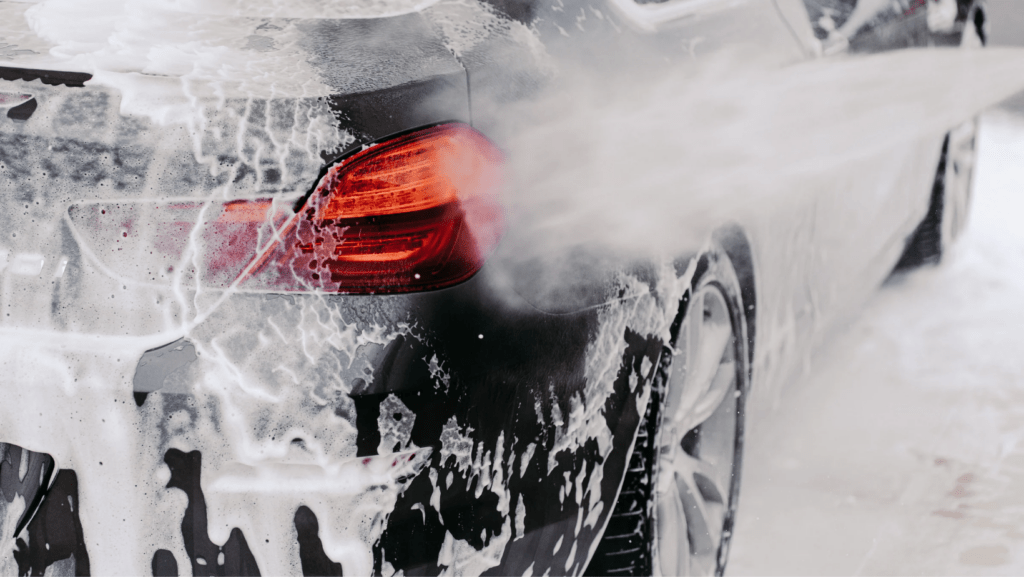
Before assessing the scale of fading of your car’s paint, first, wash your car thoroughly. It will remove any dirt, grime, or other contaminants. If you have any damage on the clear coat to the base coat, avoid using acid shampoos, as they can harm the paint. Instead, use pH-neutral shampoos. Remove iron and tar to make the surface ready for the next step. Follow our guide for deep cleaning of car paint to achieve the best results. Once you’ve washed your car, dry it thoroughly with a clean drying towel.
Step 2: Assess the Damage

Take a close look at your car’s paint again and pay attention to every detail. If your thoughts a confirmed and you don’t have any cracking or peeling car paint, move to the next step. If you notice such damages, you may need to use more complicated repair techniques or visit a professional detailing service. In some cases, peeling car paint means that the best way to resolve it is a complete repainting of a car part.
Step 3: Apply the Polishing Compound or Paint Restoration Product
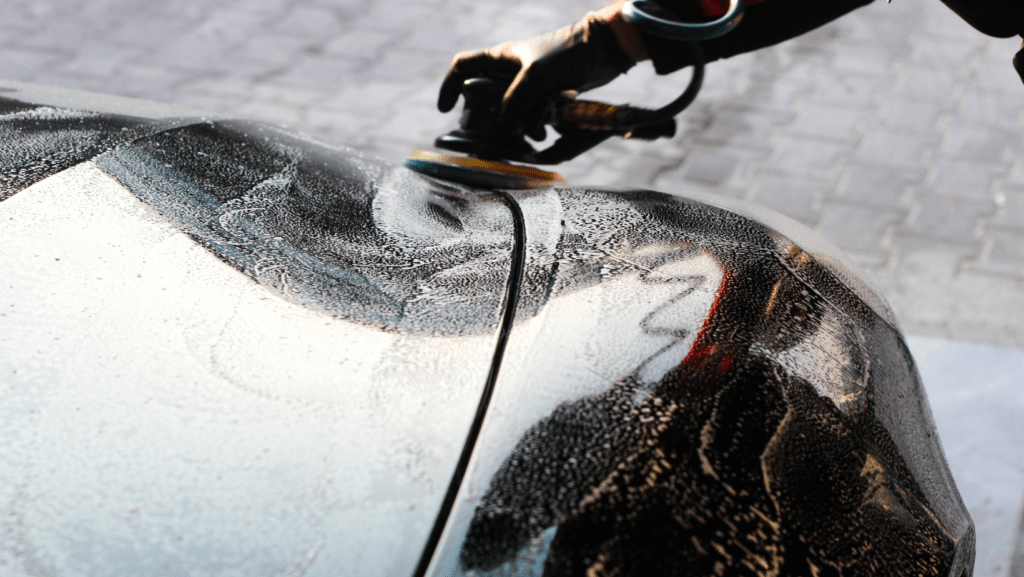
If you are using a polishing compound, apply a small amount of product on a clean applicator pad or microfiber towel. Spread the product on the affected area using circular motions. Be sure to follow the product’s instructions carefully and avoid applying excessive pressure to minimize the risks of damaging the paint. Polishing will also help you to remove scratches from your car. You can find specialized compounds for fixing faded paint by colors. Choose a matching color for your car and restore the paint. Such compounds have paint cleaners that remove oxidation and brighten car color to its natural look.
Step 4: Buff and Wax
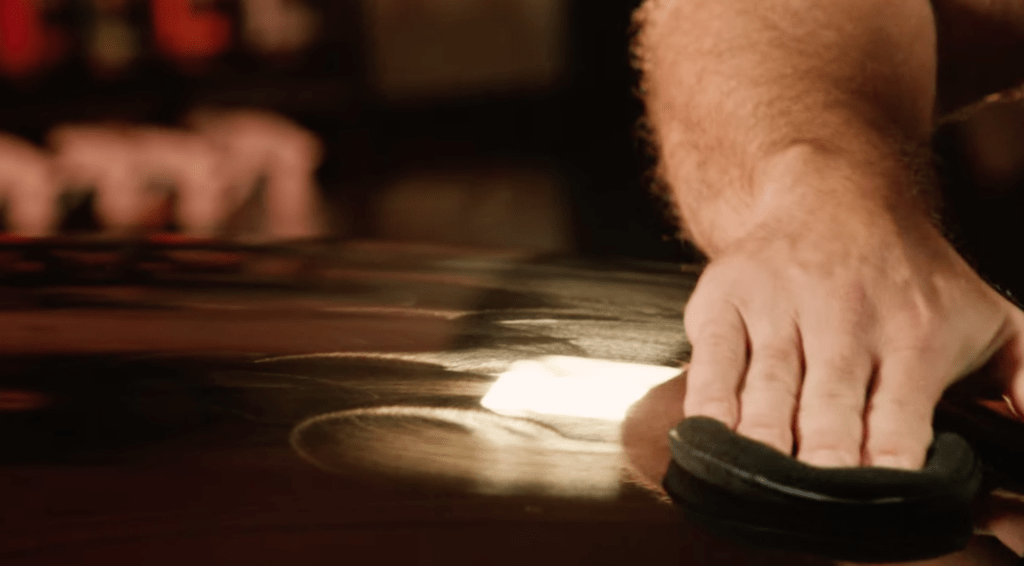
After compounding your car’s surface, use a clean microfiber towel to remove any product residue and buff the surface. After, apply a wax coating to protect the paint and give it a glossy finish. Use high-quality waxes to provide the best protection and shine to your car.
Step 5: Maintain Your Car’s Paint
Using compounds means cutting a tiny layer of your paint, which means you cannot make such procedures unlimited times. That is why we need to prevent fading of car paint again. For this, you should wash and wax your car regularly and avoid harsh chemicals and direct sunlight as much as you can.
By following these steps, you can restore the moderate fading of your paint and boost the shine and color deepness of your car. However, if you notice severe damages or have some issues with a repair or assessing your fading scale, feel free to seek professional help.
Maintenance Tips to Prevent Faded Car Paint
I believe that the best way to fix paint fading is preventing your paint to start fading. If you want to keep your car’s color deep and shiny, you should follow these car care tips:
Regular Car Washing: A Simple Yet Effective Solution
One of the easiest ways to prevent faded car paint is to wash your car properly. Properly means avoiding harsh or household chemicals on your paint. Do not use abrasive materials while washing. Wash your car on time. Washing a car once a year won’t save the paint surface from fading.
Waxing or Ceramic Coating: Keeping Your Car Shiny and Protected
Despite regular car washing, another key factor in preventing faded paint is car waxing or ceramic coating. Wax and ceramic provide a protective barrier from the sun’s UV rays and other environmental factors that can cause paint damage. Also, protective coatings minimize the risks of harsh contaminants breaking into the car’s paint and destroying it.
It’s important to use high-quality products for wax or ceramic coatings for automotive use. Such products will create proper protection on your car’s paint. Depending on the wax you use, we recommend waxing your vehicle every one to six months to keep the protective layer intact. Some car waxes you should reapply more often. Ceramic coating lasts longer and can protect the vehicle for several years.
Conclusion
Faded and oxidized car paint can become a frustrating problem that can lead to a complete repainting of your car and ruin its appearance. However, with proper knowledge and enthusiasm, you can prevent and repair faded and oxidized car paint.
Once you know what causes car paint fading, like UV exposure and harsh chemicals, you can effectively prevent and protect your vehicle from them. When you want to prevent fading of your car, don’t forget about regular washing and protecting the car’s paint with wax or ceramic coatings. Following our step-by-step guide and tips for DIY repair of moderate fading on the car’s surface you can restore it even at home.
Don’t let faded car paint ruin your vehicle’s fresh and shiny look. And don’t forget to restore black plastic on car! Take action today to protect and maintain your car’s paint job.
